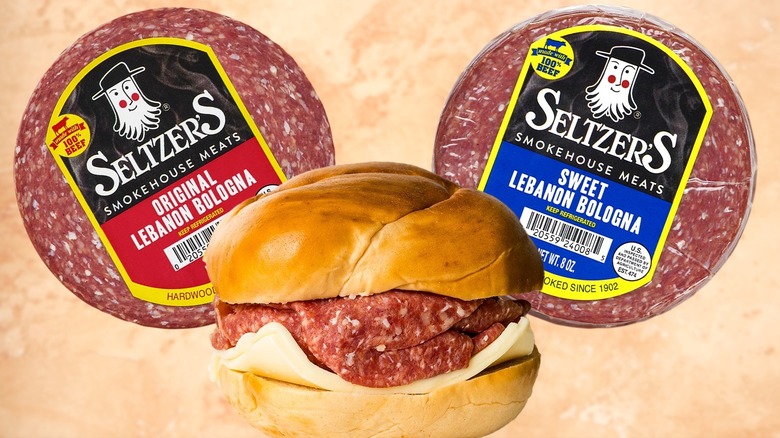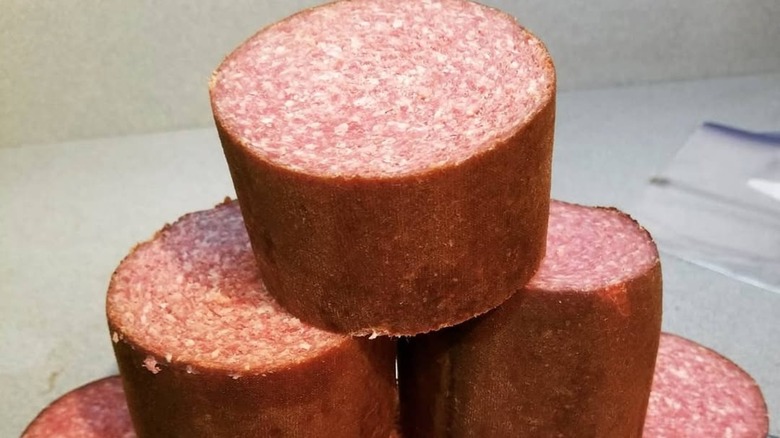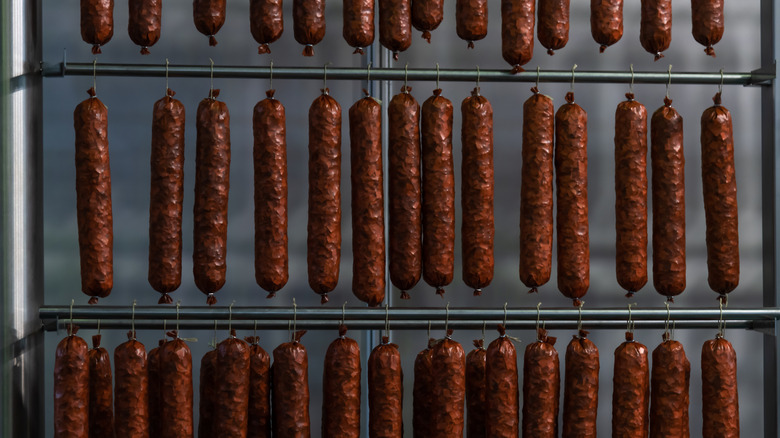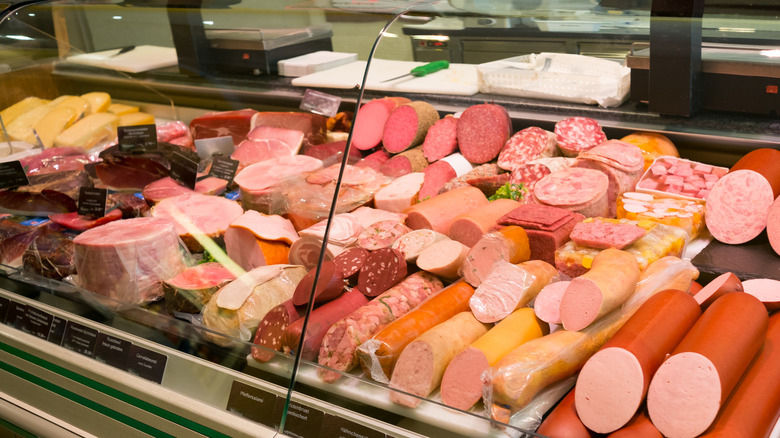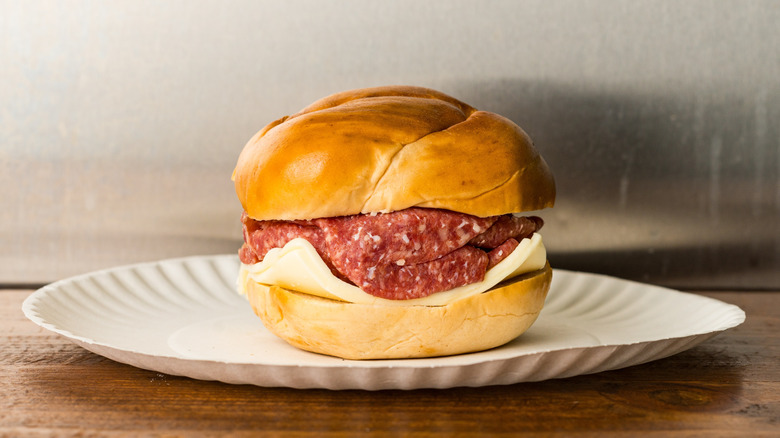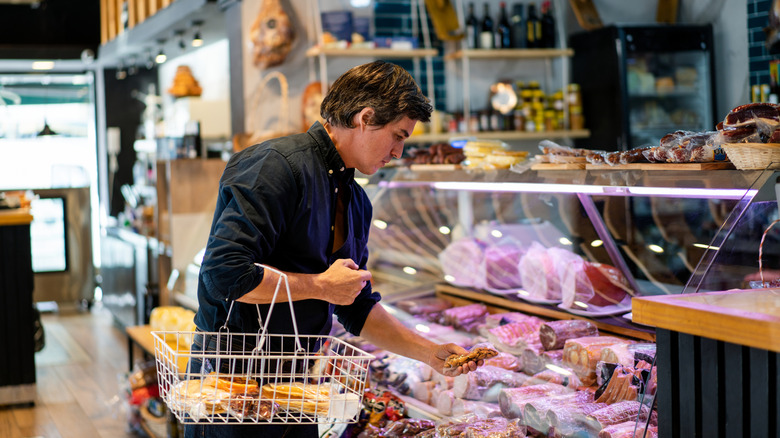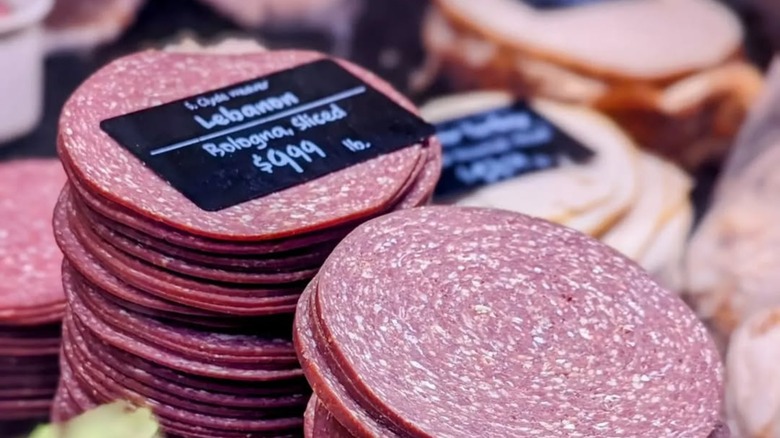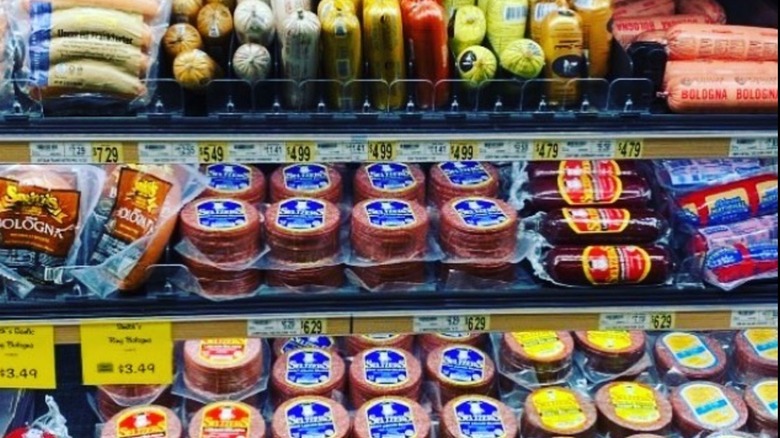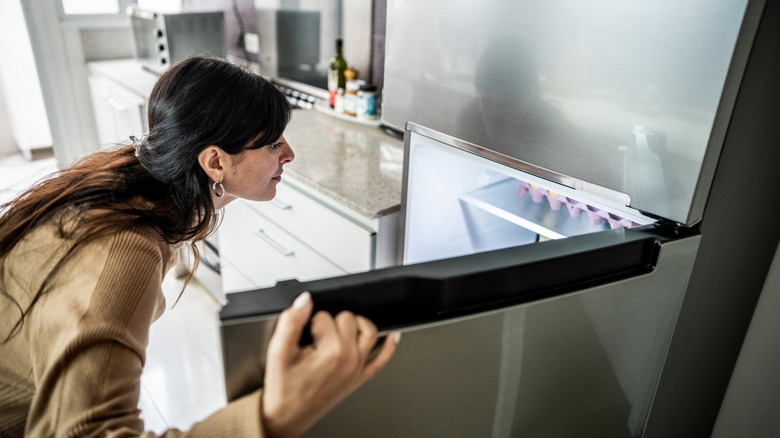What Is Lebanon Bologna?
We may receive a commission on purchases made from links.
Some foods have passionate fans because they're trendy. Lebanon bologna is far from a flash in the pan. Beloved by cold cut aficionados and Central Pennsylvania residents alike, this cured meat has been tantalizing taste buds for more than 200 years. What draws people to Lebanon bologna is its intriguing flavor profile, which is best described as a combination of sweet, tangy, and smoky. For many, Lebanon bologna is an iconic food. The deli meat even has a small museum devoted to it, located at famous Lebanon bologna producer Seltzer's Smokehouse Meats' outlet store in Palmyra, Pennsylvania.
Whether you've never had it or are already a fan, let's dive into everything you need to know about Lebanon bologna, including how it's made, what's in it, and even the weird way it ties into some people's New Year's Eve celebrations. We'll also give you some common and not so common Lebanon bologna serving suggestions.
What is Lebanon bologna?
Lebanon bologna is a fermented and cured meat, first made in the 18th century by Pennsylvania Dutch settlers. Its name comes from the town and county of Lebanon, Pennsylvania, where the dish has its roots. While it's considered a variant of bologna due to its similar curing process, Lebanon bologna has a tougher texture than the regular bologna you might have in your sandwich, and looks more like salami. Another big difference is in how both meats' names are pronounced. While regular bologna is pronounced "ba-lo-nee", those in the know will tell you that it's "bol-o-nah" when you're talking about Lebanon bologna. You could partially chalk this up to local dialects, but for many it's also an important way to differentiate the two kinds of deli meats. Perry Smith, who's been an employee of famous Lebanon bologna producer Seltzer's Smokehouse Meats for more than four decades, told local Lebanon publication LebTown, "It's totally unique....It's not bologney. It's bologna."
That may sound like a diss, but there is a real distinction. Unlike other bologna varieties, Lebanon bologna contains only beef. Another thing that sets it apart is its unique, smoky and sweet flavor profile.
How is Lebanon bologna made?
Lebanon bologna is made in several steps. First, the meat –- which, in real Lebanon bologna, is always 100% beef –- is ground up. After that, salt, sugar, and seasonings are mixed in. Each brand of Lebanon bologna uses its own combination of spices. The amount of sugar also varies from brand to brand, which is why no two types of Lebanon bologna taste exactly the same. Some Lebanon bologna producers will even use different seasoning and sugar combinations to produce different Lebanon bologna varieties.
Once the meat, sugar, salt, and seasonings have been mixed together, fermenting agents are added. Then, the meat is refrigerated for around 10 days, allowing the fermenting process to do its thing. Once it's ready, the mixture is rolled into log shapes and put into casings. These are hung in a smoker or smokehouse for several days. When the smoking process is finished, the Lebanon bologna log is cooled for a few additional days. Now, it can be cut and packaged. At last, it's ready to be sold — and eaten!
If you prefer to do things in a more hands-on manner, you can forego the buying step and make your own Lebanon bologna. You'll find lots of tutorials online.
Lebanon bologna vs. regular bologna
While both are deli meats and share part of a name, Lebanon bologna and regular bologna differ in a few significant ways. The most immediately noticeable is their appearance. While regular bologna is typically a smooth-textured pinkish colored cold cut, Lebanon bologna looks a lot more like salami, with a darker red, mottled appearance. The two deli meats' appearances also reveal another difference. Unlike regular bologna, Lebanon bologna is considered a semi-dry sausage. In other words, it has the firmness and texture of dry sausage, but it's still moist. The other most noticeable difference is in taste. While there are some differences between makers and brands, regular bologna tends to have a mild taste. Lebanon bologna, on the other hand, has a stronger flavor that's often described as smoky, tangy, and sweet.
A less immediately noticeable difference, but one that's crucial, is that regular bologna is made up of different kinds of meats, and can include scraps of turkey, pork, or chicken, in addition to beef. Lebanon bologna, on the other hand, only contains beef, typically of the lean variety. Ingredients like water, broth, and fat are often added to regular bologna, but never to real, quality Lebanon bologna.
What does Lebanon bologna taste like?
Lebanon bologna is one of those foods with a distinctive taste that's hard to describe. Fans often use words like "smoky" and "tangy" to describe its strong flavor. Some Lebanon bologna brands also produce Lebanon bologna that uses more sugar than the average recipe, so "sweet" is another word that frequently comes up. As we've said before, some people familiar with Lebanon bologna will simply say the meat tastes like salami. Summer sausage is another deli meat that's frequently compared to Lebanon bologna. These are helpful descriptions, and definitely cover Lebanon bologna's texture, but they also sort of make the flavor profile of this legendary meat seem a little more ordinary.
It's important to keep in mind that not all Lebanon bologna tastes the same. As we've mentioned, its flavor will be influenced by the combination and amount of seasonings and sugar the person or company making it decides to add. The amount of time Lebanon sausage is left to smoke can also have an impact on that smoky taste that many fans notice. Taste differences aside, keep in mind that, as a general rule, Lebanon bologna is more flavorful and has a stronger taste than deli meats like ham or regular bologna.
How to serve Lebanon bologna
You can buy Lebanon bologna pre-sliced, or in logs that are often referred to as "chubs". Like most of its fellow deli meats, Lebanon bologna is typically served in cold slices. Lebanon bologna can be a part of cold cut classics like a sandwich, charcuterie board, or salad. Many fans also add Lebanon bologna to their hors d'oeuvres. One popular choice is to spread cream cheese onto a slice of Lebanon bologna, then roll the slice up, resulting in a spiral of smoky and creamy goodness. A common variant of this includes a pickle in the roll. But you could also serve Lebanon bologna on crackers, plain or with other garnishes or spreads to change up the taste.
Lebanon bologna can be used in cooked and hot dishes, as well. For instance, you can add Lebanon bologna to omelettes and quiches. Or simply heat a few slices and serve them along with eggs for a hearty, flavorful breakfast. It's also great as a burger topping. All this goes to show that there are countless ways you can use Lebanon bologna to elevate a dish. You'll find lots of inspiration by searching for recipes online. For instance, many Lebanon bologna producers and smoked meat companies feature recipe ideas on their websites.
Where to buy Lebanon bologna
You may be able to find Lebanon bologna in your favorite major grocery store deli sections, especially if you live in or close to central Pennsylvania. If you can't get it there, you may want to try hunting for a specialty grocery store or deli that offers it. If those are also no-goes, not to worry. If you're too far afield from Lebanon bologna's typical region, you can easily order it online, through big sites or in some cases directly from well-known Lebanon bologna producers and retailers.
For instance, if you're hankering for that sweet, smoky taste, you can always purchase Lebanon bologna on Amazon by the pound for anywhere from $4.93 to $159.99. You can also purchase Lebanon bologna from Walmart for $6.97. Or you can purchase Lebanon bologna online directly from Seltzer's Smokehouse Meats for $6.00 and up.
Nutritional Information about Lebanon bologna
Real Lebanon bologna should contain only beef as its meat ingredient, as well as spices, sugar, and salt. The spices and amount of sugar can vary depending on the company or individual making it. Lebanon bologna usually contains only lean beef, which is one of the reasons you'll sometimes hear it called healthy. Another reason is that quality Lebanon beef shouldn't contain fillers like added fat, water, or cuts of other types of meat. Among other advantages, this means that Lebanon bologna is a good source of protein. According to NutritionValue.Org, a single portion will give you an average of 11 grams of protein, or 22% of the daily recommended average. Lebanon bologna generally contains low levels of sugar and carbohydrates — typically about 0.3 grams per serving, which still makes it 0% of the daily recommended value.
On the other hand, like most cured meats, Lebanon bologna is high in sodium. NutritionValue.Org reports that an average single portion of Lebanon bologna contains 783 milligrams of sodium, or 34% of the daily recommended intake. In addition to added salt, the sodium content of Lebanon bologna is also due to nitrate and nitrite compounds, which preserve the beef. As in many cured meats, nitrate and nitrites are crucial in the curing process of Lebanon bologna. Unfortunately, some nitrate compounds, like nitrosamines, have been tied to increased risk of health conditions like heart disease and cancer. One bit of good news is that many sources report that levels of nitrite in Lebanon bologna seem to reduce the longer the curing process takes.
Varieties of Lebanon bologna
While the basic recipe stays the same, different brands of Lebanon bologna will have slightly different taste profiles because of the spices used in their recipes. Sugar is also a factor. Lebanon bologna is often described as having a sweet taste, due to sugar being one of its key ingredients. But some brands and artisanal producers will add extra sugar for additional sweetness. For instance, Seltzer's Smokehouse Meats sells an original and a sweet version of its signature product, as well as a double smoked sweet version that includes brown sugar. Some artisanal producers and companies, including Seltzer's, also add honey to some of their Lebanon bologna offerings. Some other details can influence Lebanon bologna's taste, including how long the meat is left to smoke.
With all of these factors in play, it's no wonder that fans often have a favorite Lebanon bologna variety and brand. According to online customer reviews, the best Lebanon bologna is made by Seltzer's Smokehouse Meats or Weaver's (Weavers-Kutztown Bologna Inc). But if you visit central Pennsylvania, you may discover a personal favorite at a small local deli or butcher's.
How to store Lebanon bologna
Because Lebanon bologna is a semi-dry sausage, you can't leave it out at room temperature. Instead, Lebanon bologna should be kept refrigerated. Many sources will tell you that Lebanon bologna will last an impressive 14 days in the fridge, but those of us who've dealt with refrigerated deli meats may have doubts about that. The team at Lebanon bologna producer Stoltzfus Meats would agree, confirming that at least as far as its Lebanon bologna goes, an opened package will probably last for about 7 days in the fridge, ideally stored in an airtight container. Since this may vary by brand, the smoked meat producer reminds consumers that if Lebanon bologna feels slimy or smells bad, you should throw it out regardless of how many days it's been in the fridge.
If you've bought a lot of Lebanon bologna, not to worry. An unopened package or chub of Lebanon bologna can last up to three months in the fridge. Lebanon bologna can also be frozen if it hasn't been opened. It should be kept sealed in its original packaging and put into a freezer bag, plastic wrap, or aluminum foil as well. If it's sealed this way, Lebanon bologna can last three to six months in the freezer, depending on the brand. When you're ready to eat it, let the package thaw in the refrigerator, rather than at room temperature, to protect it from bacteria as much as possible. This will usually need to be an overnight process, but depending on the amount of Lebanon bologna in question, it might take up to 24 hours.
A Lebanon bologna New Year's tradition
If you want more proof of just how beloved Lebanon bologna is, you only need to look at what happens in Lebanon, Pennsylvania, on New Year's Eve. Since 1997, the town has held a celebration where the new year isn't rung in by a dropping ball, but rather by several long chubs of Lebanon bologna that are suspended at the top of a crane and ceremoniously lowered during the countdown.
In the most recent Bologna Drop, which rang in 2025, the bologna was provided by Seltzer's Smokehouse Meats. After the festivities, it was donated to a local charity. The December 2024 New Year's Eve celebration in downtown Lebanon, Pennsylvania also included a DJ and a coloring contest for kids. You might not be surprised to know that the coloring page featured four dancing chubs of Lebanon bologna, each labeled as a different flavor variety.
